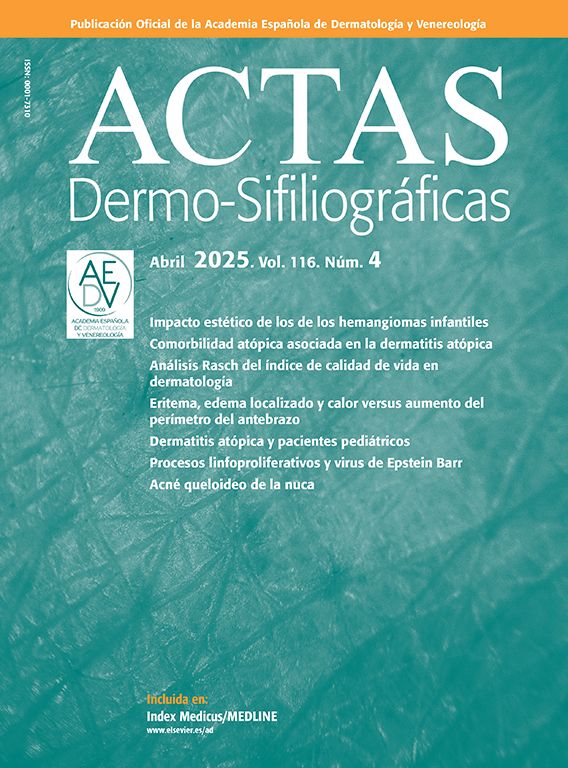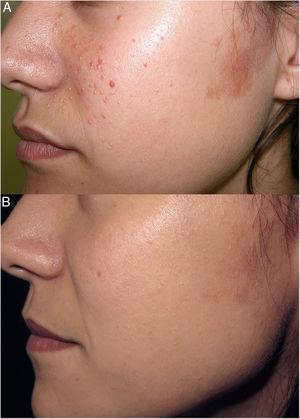An 84-year-old man with a diagnosis of cutaneous psoriasis controlled with a 30-year history of topical treatments and psoriatic arthritis in follow-up by Rheumatology, attended the Dermatology consultation for the appearance, over the past 2 months, of painful, ulcerated and necrotic lesions on the glans (Fig. 1).
The lesions had initially appeared as millimeter-sized pustules and had progressively turned into ulcers, with erythema and induration of the surrounding skin. The patient denied practicing risky sexual behaviors or applying topical products to this location. He was asthenic, but afebrile, and did not present associated systemic symptoms or other types of mucocutaneous lesions.
On physical examination, no inguinal lymphadenopathy was palpated. Ophthalmological and neurological involvement was ruled out. The microbiological culture of the lesions turned out negative. Lab test results – including screening for sexually transmitted infections and autoimmunity study – turned out normal.
A skin biopsy of the edge of one of the lesions was performed, which showed a nonspecific ulcer, with a dense, inflammatory and predominantly neutrophilic infiltrate (Fig. 2).
What is your diagnosis?
DiagnosisPyoderma gangrenosum
Cours of the disease and commentaryThe patient was diagnosed with pyoderma gangrenosum (PG) of the penile glans. Oral corticosteroids were prescribed at a dose of 1mg/kg/day – which was later down titrated – with significant clinical improvement. Afterwards, although dapsone was administered as maintenance treatment, at a dose of 50mg/day, the patient presented acute renal failure that required hospitalization and forced the withdrawal of the drug. Finally, adalimumab 40mg every 14 days was administered, achieving complete remission of the ulcers (Fig. 3).
PG is a rare and rapidly progressive neutrophilic dermatosis. Although its etiology remains unknown, PG has frequently been associated with other systemic inflammatory diseases, which may be present previously or appear after PG. Inflammatory bowel disease, arthritis, and hematologic diseases are the most related. Our patient suffered from psoriatic arthritis, an association described in the literature.
Clinically, PG presents as a painful and rapidly progressive ulcer. It usually begins as a follicular pustule with rapid growth and associated tissue necrosis. The surrounding skin is typically erythematous or violaceous and there may be edema or infiltration. The phenomenon of pathergy is characteristic of the disease.1
PG most frequently appears on the lower legs, predominantly in the pretibial area. Involvement of other locations of the skin surface, such as the head and neck, trunk, arms, and peristomal skin, has been reported. Although genital signs of PG are rare, some cases of PG of the penis have been reported.2 Therefore, we emphasize the importance of considering PG in genital ulcers.
The diagnosis of this entity is mainly clinical and by exclusion of other diseases. Therefore, additional tests, such as skin biopsy, serologies and microbial cultures, should be performed to establish the diagnosis. The histological findings of PG are nonspecific; while premature lesions may show a perifollicular inflammatory infiltrate, evolved lesions may present as a necrotic or ulcerated epidermis with a diffuse and dense infiltrate of neutrophils, lymphocytes and histiocytes in the papillary and reticular dermis.3
There are no standardized clinical practice guidelines on the management of this entity. Therapeutic options are mainly based on the control of the underlying disease and the use of immunosuppressive agents, such as corticosteroids, cyclosporine, and tumor necrosis factor (TNF) drugs.4 Although infliximab has been classically used in inflammatory bowel disease-related PG, recent studies have been published on the use of adalimumab in PG, with a good response, as observed in our patient.5
Conflict of interestThe authors declare that they have no conflict of interest.











